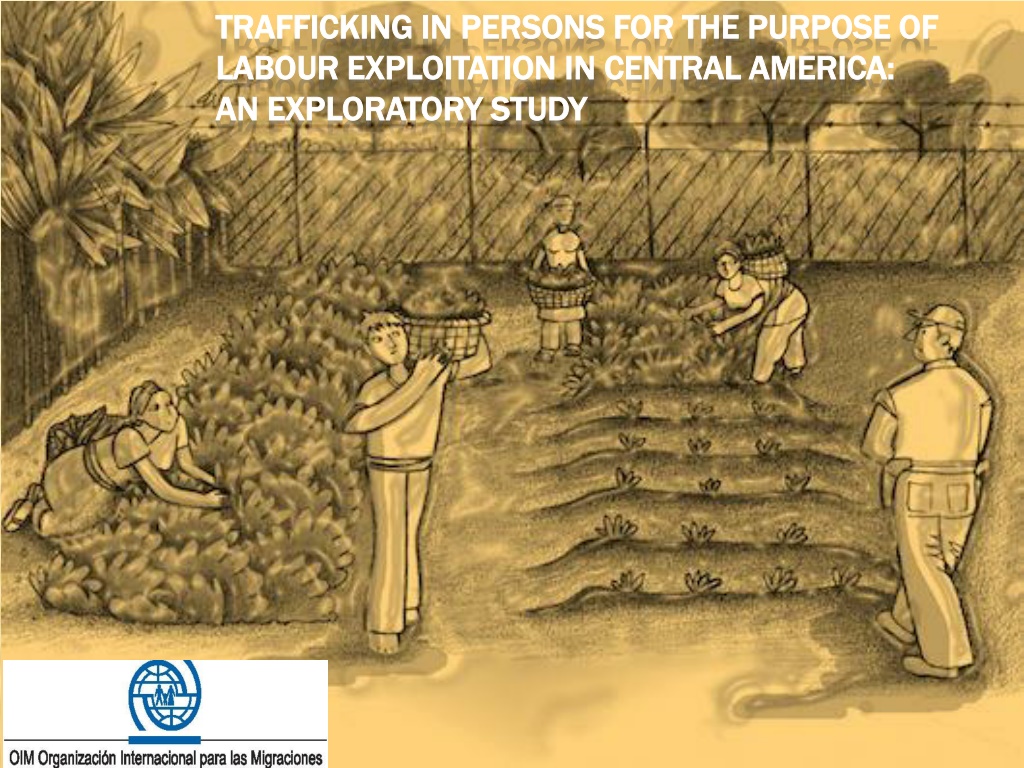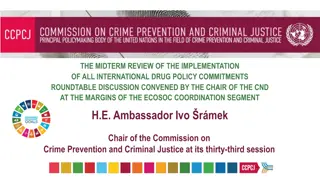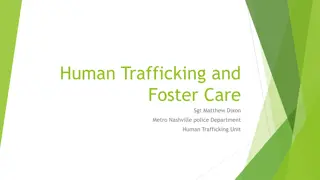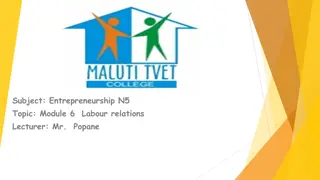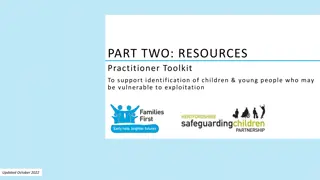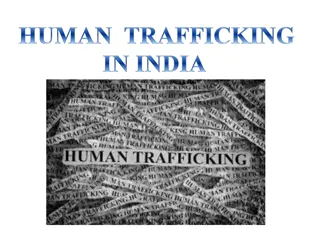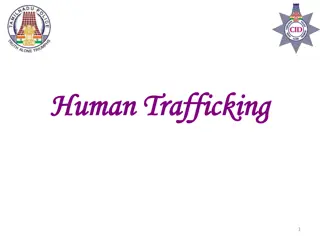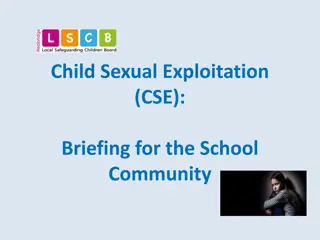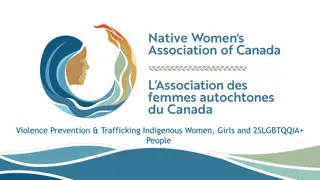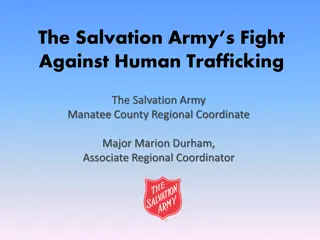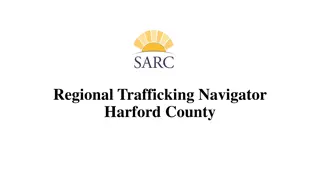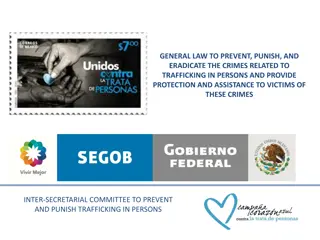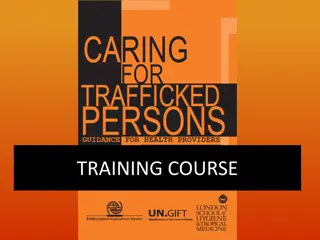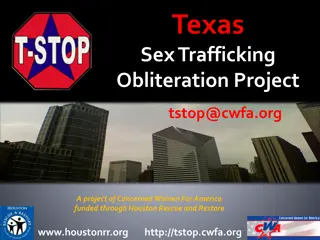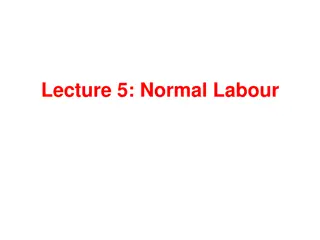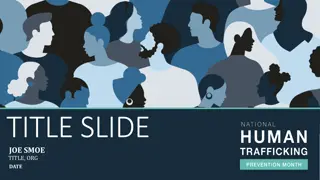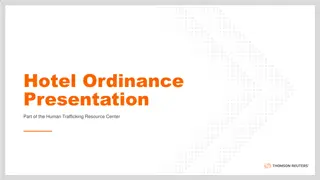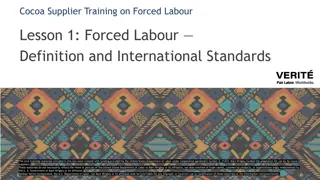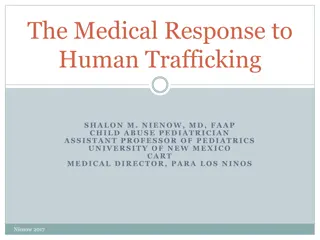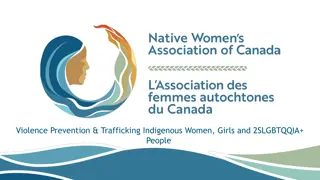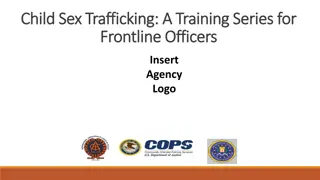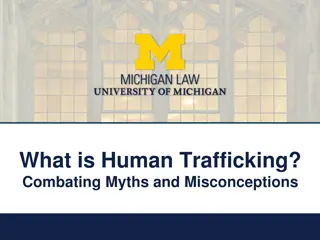Exploring Trafficking in Persons for Labour Exploitation in Central America
This exploratory study delves into the issue of trafficking in persons for the purpose of labour exploitation in Central America. It aims to identify and analyze information on the characteristics, routes, and populations affected by this crime. The study also focuses on formulating recommendations for government authorities, NGOs, and other stakeholders to prevent trafficking and improve interventions for victims.
Download Presentation

Please find below an Image/Link to download the presentation.
The content on the website is provided AS IS for your information and personal use only. It may not be sold, licensed, or shared on other websites without obtaining consent from the author. Download presentation by click this link. If you encounter any issues during the download, it is possible that the publisher has removed the file from their server.
E N D
Presentation Transcript
TRAFFICKING IN PERSONS FOR THE PURPOSE OF TRAFFICKING IN PERSONS FOR THE PURPOSE OF LABOUR EXPLOITATION IN CENTRAL AMERICA: LABOUR EXPLOITATION IN CENTRAL AMERICA: AN EXPLORATORY STUDY AN EXPLORATORY STUDY
OBJECTIVES To identify, systematize, and analyse available information information about trafficking in persons for the purpose of labour exploitation in Central America; To help to gather knowledge about the characteristics, dynamics, routes and populations affected dynamics, routes and populations affected by this crime; available characteristics, To help understand and provide a context in persons for the purpose of labour exploitation within the broad framework of socioeconomic, labour, and migration policy and the general institutional response. provide a context for trafficking
OBJECTIVES To identify specific protection and assistance needs specific protection and assistance needs of surviving victims of trafficking for the purpose of labour exploitation; To formulate recommendations recommendations for relevant government authorities, NGOs and other stakeholders with the aim of preventing the crime; To develop appropriate strategies for the detection and appropriate strategies for the detection and identification of situations of trafficking in persons for identification of situations of trafficking in persons for the purpose of labour exploitation the purpose of labour exploitation and to improve interventions for surviving victims.
CONCEPTUALIZING TRAFFICKING IN PERSONS FOR THE PURPOSE OF LABOUR EXPLOITATION Attracting persons with the aim of subjecting them to Attracting persons with the aim of subjecting them to forced labour or services through coercion, deception, forced labour or services through coercion, deception, force, abuse of power or a vulnerable situation. force, abuse of power or a vulnerable situation. This means that This means that: : The labour or services are provided under threat of punishment. The work is carried out in an involuntary manner (ILO).
WHERE AND WHEN THE RESEARCH STUDY WAS CONDUCTED Countries: Guatemala El Salvador Nicaragua Costa Rica Honduras (unpublished) Field work conducted in 2011
Sources: Sources: Interviews with key Interviews with key informants; informants; Reviews of Reviews of publications and publications and newspapers; newspapers; Reviews of judicial Reviews of judicial and administrative and administrative records; records; Consultation Consultation workshops with workshops with experts; experts; Interviews with Interviews with surviving victims. surviving victims. Interviews with 65 officers: (15 ES, 18 GT, 9 NI, 8 HN, 14 CR)
Country Country Number and Gender Number and Gender of Surviving Victims Surviving Victims of Victimization Scenarios Victimization Scenarios Destinations Destinations El Salvador El Salvador 41 32 men 9 women Maquilas Plantations 1 El Salvador Costa Rica Nicaragua Nicaragua 7 Household work Services Nicaragua Costa Rica Argentina 7 women Guatemala Guatemala 264 Household work Plantations Laundry services Services Guatemala Mexico Spain United States 240 men 24 women Honduras Honduras 35 32 men 3 women Plantations Household work Criminal activities: taking apart cars Honduras Mexico Rumania Guatemala Costa Rica Costa Rica 37 International fishing Criminal activities Costa Rica Mexico 37 men TOTAL TOTAL 384 384
1) An extreme expression of a continuum of exploitation and abusive relationships in the workplace that can easily become openly coercive. . SOME RESULTS
2) The globalization of labour markets and the transformation of the social and economic model, especially the liberalization of markets and the de-regularization of labour processes, seem to have an impact on the prevalence of this mode of trafficking in persons. SOME RESULTS SOME RESULTS
SOME RESULTS 3) Common victimization 3) Common victimization scenarios scenarios: Household work Maquilas Agro-industrial activities Service sector Criminal activities Other: construction 4) Common characteristics Common characteristics of these scenarios of these scenarios: Insufficiently regulated or informal economic activities Use of (irregular) migrant labour
ROOT CAUSES ROOT CAUSES Economic and political: the historic Economic and political: the historic structure of the labour market; structure of the labour market; Cultural practices which legitimize Cultural practices which legitimize labour exploitation; labour exploitation; Organized crime and impunity. Organized crime and impunity. CONTRIBUTING FACTORS CONTRIBUTING FACTORS A highly competitive global economy A highly competitive global economy and maximization of the productivity and maximization of the productivity and profits above rights; and profits above rights; Relationships of subordination Relationships of subordination between nations, at a regional and between nations, at a regional and international level; international level; Poverty, multiple types of exclusion Poverty, multiple types of exclusion and oppression. and oppression. AGGRAVATING FACTORS AGGRAVATING FACTORS Legal voids and absence of Legal voids and absence of criminal and labour institutions; criminal and labour institutions; Lack of protection during Lack of protection during migration; migration; Corruption. Corruption. SCENARIOS SCENARIOS PROMOTING PROMOTING TRAFFICKING IN TRAFFICKING IN PERSONS FOR THE PERSONS FOR THE PURPOSE OF PURPOSE OF LABOUR LABOUR EXPLOITATION EXPLOITATION
SOME RESULTS 5) Link between trafficking in persons for the purpose of labour exploitation and labour migrant smuggling. Contractors. sometimes thousands of dollars to cover costs related to transportation, visas and others, including the profits of the contractors. Workers, the majority of whom live in poverty, often have to obtain loans with high interest rates to be able to collect the money to pay the fees; sometimes contractors ask them to give something as a guarantee (deeds of their homes, land, cars) to ensure that they comply with the terms of their individual employment contracts. Usually, contractors charge fees from workers
SOME RESULTS 6) Mostly men of all ages, except in the household work sector. Usually groups of victims. This is a challenge, due to the number and gender = availability of services/programmes. 7) Internal trafficking for the purpose of labour exploitation exists in every country as well as trafficking for the purpose of labour exploitation between Mesoamerican countries, according to labour migration patterns.
8) The attraction and subjugation mechanisms are similar to other expressions of the crime. The following can be highlighted: Subjugation due to debt Constant surveillance Physical violence Threats [He] took me to work in the corn fields, and my fingers became full of sores and on top of them my wounds bled. Those that tried to escape from the corn fields were killed. They killed a woman When I saw that it was true that they were murderers I had to comply with everything, do what they said. At night they always watched the mud walls to prevent us from escaping (Surviving victim) SOME RESULTS SOME RESULTS
SOME RESULTS 9) Institutional response: Lack of knowledge lack of information; Limitations in definition/typification labour exploitation is not a crime; Administrative labour crime versus criminal / human rights; Few cases are investigated / no sentences Labour sector, limited participation in prevention, inquiry, regulation; weaknesses in identification; situations of trafficking in persons are not explored among returned or deported migrants.
